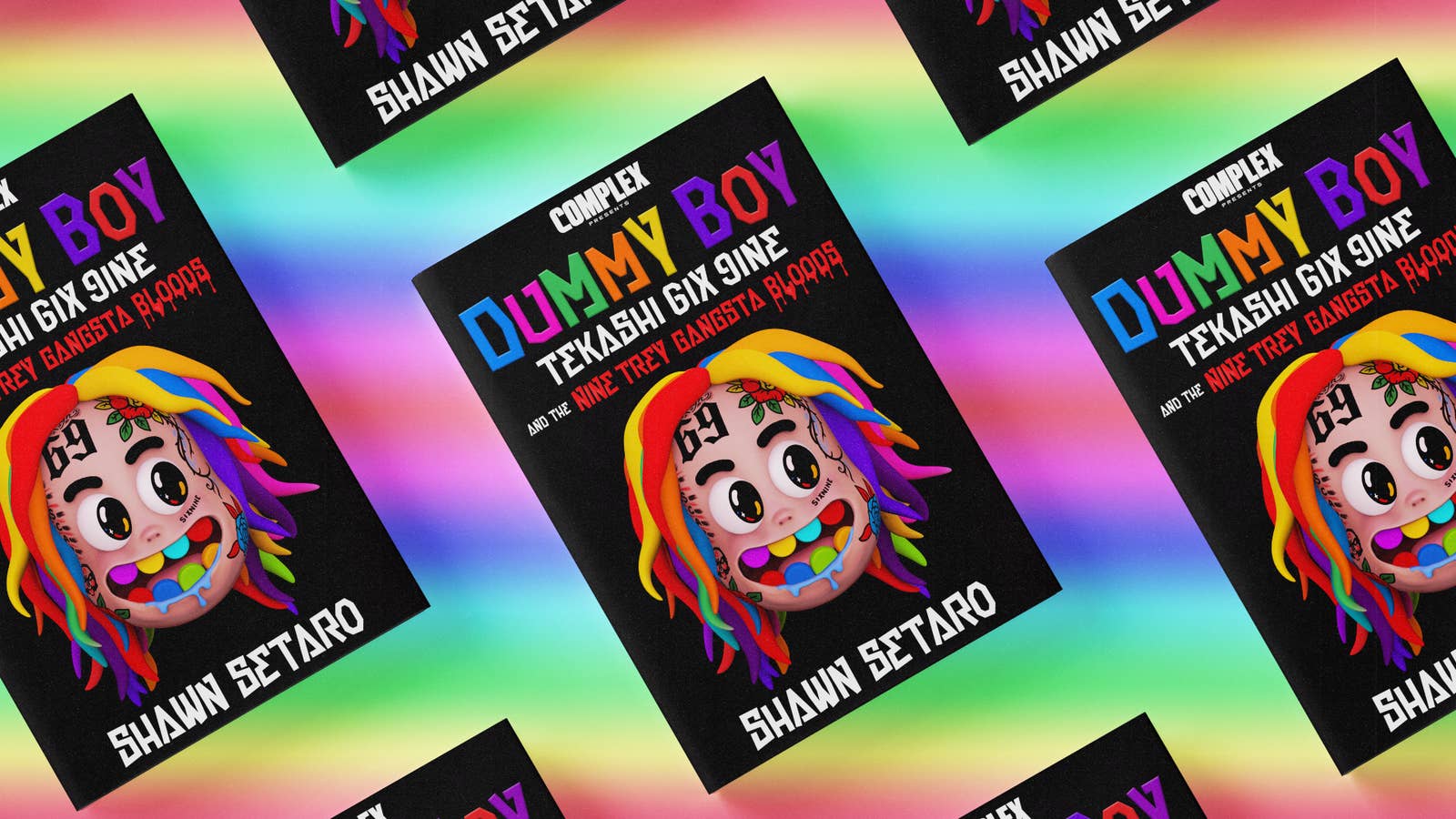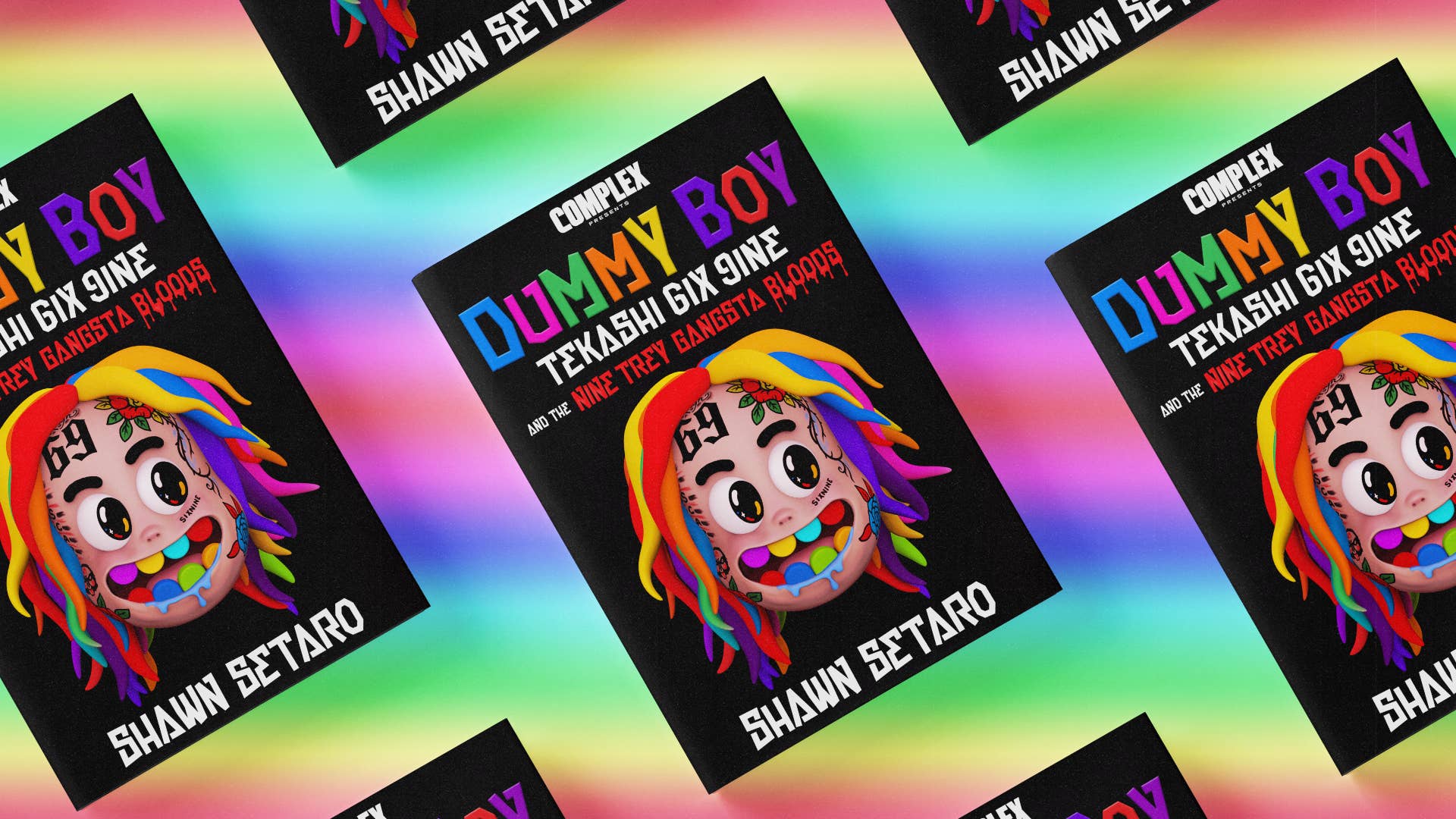
The following is an excerpt from the new book Complex Presents: Dummy Boy – Tekashi 6ix9ine and the Nine Trey Gangsta Bloods, published by Kingston Imperial. The book, by Complex reporter Shawn Setaro, is the definitive story of the rise and fall of this era’s most colorful and divisive figure in hip-hop.
Setaro saw it all go down first-hand while in court for every moment of Tekashi’s legal drama, culminating in the rapper’s public testimony and a dramatic sentencing hearing. He also talked to dozens of people close to the star, some of whom you can hear on the Complex and Spotify podcast Infamous: The Tekashi 6ix9ine Story.
Dummy Boy is the culmination of years of reporting on every aspect of the story, and Complex is proud to present this exclusive excerpt. You can order the book on Amazon or anywhere else you buy books.
It’s the fall of 2017, and 6ix9ine has signed a record deal with Elliot Grainge, the son of the most powerful man in the music business. 6ix9ine has left behind Scumgang, the Bushwick-based rap crew with which he got his start. He even has a new manager, Christian Ehigiator, to replace Scumgang’s guiding light, Peter “Righteous P” Rodgers. 6ix9ine’s one lingering music business relationship is with Yaksha, the founder of Slovakia’s Fck Them label—a bizarre overseas connection that gave the rapper significant boost early in his career. In addition, 6ix9ine’s in the middle of a feud with Trippie Redd, who not coincidentally is also signed to Elliot Grainge’s label.
6ix9ine has recently gotten to know Christian’s longtime friend Seqo Billy—a member of the Nine Trey Gangsta Bloods gang. Their members are frequently referred to as “Billys.” Seqo’s main hangout is “Maddy.” That’s the Bed-Stuy, Brooklyn, brownstone on Madison Street where Seqo’s aunt, known as “Ms. Tr3yway,” resides. Kifano “Shotti” Jordan, a powerful figure in Nine Trey, is close to both Seqo and Ms. Tr3yway, at least for now.
6ix9ine has a new song, “Gummo,” that he and his best friend, Trife Drew, have been laboring over for weeks. But a song is nothing without a video. That’s where our story begins…
Chapter 3: Gummo
In the fall of 2017, Tekashi 6ix9ine had a record label, a manager, and a new direction. He was giving up on the rock-influenced sounds of his Scumgang days, and was ready to go commercial. The first salvo in this direction was “Gummo,” the song he’d labored over with his friend Drew.
But for an artist as visual as Tekashi 6ix9ine, a song was nothing without a video. And this was where Seqo Billy came into play. Seqo had an idea. He wanted to, as he says, get Danny “in tune with the urban community more.” And Danny was thrilled to have a real-life gang member on his side. He even shouted out Nine Trey in the lyrics to “Gummo.” “In the hood with them Billy n****s,” he rapped.
So, when it came time to make the video for “Gummo,” Seqo and Danny’s desires melded into a plan. They would shoot the video at Maddy, with real-life Nine Trey members there to lend credibility to the rainbow-haired rapper.
Maddy was owned by Ms. Tr3yway’s mother, who still lived there. She appeared in the clip and later, after its world-beating success, was teasingly called the “‘Gummo’ grandma” by some of her then-coworkers at the Department of Corrections.
The idea of the video was to play up Danny’s Mexican heritage. Just like Righteous P had, Danny’s manager Chris realized that his heritage could be advantageous. Donald Trump was president, and “build the wall” sentiment was everywhere. So announcing Mexican allegiance loud and clear, as Danny did in the video by wearing a Mexico soccer jersey, would surely get attention.
There was just one issue. There was no way a bunch of guys in Red Stuy, Nine Trey members or otherwise, were going to show up en masse for a video shoot for someone they didn’t know—especially someone from Bushwick. Some subterfuge was called for.
Seqo told everyone around to come to a video shoot—for him. They were going to shoot a clip, he said, for his own song “Billy Dat.” And a number of Nine Trey guys showed up. Danny bought a whole bunch of red bandanas. Chris, nursing a hangover from the previous night, skipped the shoot.
Almost immediately after arriving, Seqo took Danny over to Shotti, who was at the top of the stairs outside Maddy. If Nine Trey was going to represent this rapper, the gang’s big homie needed to know who they were repping.
“What’s up, homie?” Shotti said. “We here for you. Whatever you need, we here. Couple of the homies gonna show up in a little bit. In the meantime, you need anything?”
“I’m good,” Danny replied. “You need anything?”
“Get a bottle of Henny and something to eat for the guys.”
Danny bought two large bottles of Hennessy and brought them back to Maddy, fuel for the shoot to follow. The video shoot got started in the mid-afternoon, and only took a few hours. It was a block party. They played songs from Seqo, from Danny, and from the Pop Out Boyz, another local crew who were tight with Seqo. Members of the group and their affiliates had been arrested back in 2016 for credit card fraud—an incident that became national news because they rapped about that very practice on a song called “For a Scammer.”
When the police showed up, Ms. Tr3yway sprang into action. She got everyone to pull a grill out and act like they were just having a cookout—not an uncommon early fall outdoor activity in that neighborhood. All in all, the crowd of about 40 had a great time drinking Henny, mugging for the cameras, and dancing to the music. At one point during the day, Danny tried to convince Shotti that he was destined for fame. Shotti was posted up at the top of the stairs, and Danny said, “Yo bro, this shit is gonna be huge.”
After it was all done, Seqo called Chris. “Yo, you’d be so proud of your boy,” he said. “He brought bandanas for the homies. He bought two bottles of Hennessy—the big joints.” Altogether, the video cost around $150.
Less than a month after that filming, the video was ready to go. Danny gave it to Yaksha to release on Fck Them’s YouTube page—a sort of final thank you, since he now had a record deal, a real manager, and other business ties. He wasn’t yet authorized to release the clip through his label, so this was the quickest way to get it out into the world.
The response was instantaneous. Danny’s friend Schlosser wasn’t a fan of the track originally (“I was there when he first ever heard the beat, and I was like, ‘This shit sucks.’”) But he saw the mania firsthand. Even before the full video came out, when just a teaser was available, people were going nuts. Schlosser recalls hearing a car drive by, blasting just the few seconds of the song that was then available on a continuous loop.
“Energy-wise and visually, what he did was powerful,” Schlosser says now. “Because we never seen that. We never seen a fucking rainbow-haired Blood. Fuck if he was Black or anything. He just broke the whole barrier.”
Not long after the video dropped, Schlosser and Danny were at the Applebee’s in Times Square.
“Some weird dude ran up to us and got on his knees like, ‘Oh, 6ix9ine,’ and was kissing his shoes and shit,” Schlosser remembers. That was when Schlosser realized that everything had changed. His friend Danny had really turned into Tekashi 6ix9ine, rap star.
“Energy-wise and visually, what he did was powerful. Because we never seen that. We never seen a f*cking rainbow-haired Blood.”
What made “Gummo” work was exactly the incongruity that Seqo, Chris, and Tekashi sensed. Who was this rainbow-headed, rainbow-grilled Mexican kid? Why was he around all these hard-looking guys flaunting their Blood affiliation? Was he friends with them? How? Was it a joke? Was it serious? Whatever the answers to these questions, people couldn’t look away. In fewer than three months, the video garnered over 70 million views.
Elliot Grainge, Tekashi’s new label head, was blown away. Within weeks, he called Chris. “How the fuck is this doing so many numbers? This shit is gonna be huge,” Tekashi recalls him saying. As the view count clicked ever higher, Shotti took notice. And he called Seqo.
“This little n***a knows what he’s doing,” Shotti said. “I thought all that rainbow-hair shit, he was bugging for that, but he know what he’s doing. Tell him to stay in touch.”
Tekashi did. By the time he was ready to record a follow-up song just a few weeks after “Gummo” was released, Shotti was in the studio with him, making sure to appear on camera in their very first interview.
By then, Tekashi already had his patter down. And he would use it for the rest of his rise to the top. Just like when he said that his Scumgang crew members Righteous P and ZillaKami went behind his back with Epic Records, this time he was yet again the victim. But instead of the perpetrators being his friends, it was now unnamed “haters.” He was channeling their antagonism and using it to make himself successful. It’s all there in the very first sentence of his first interview.
“First of all, I want to say to all my haters that, you know, I really appreciate y’all, ’cause two weeks ago, nobody was jacking Tekashi 6ix9ine, but y’all n****s made me relevant.”
Tekashi’s beef with Trippie Redd was still going strong. In the interview, he crowed over the fact that “Gummo” was on the verge of gaining more YouTube views than Trippie’s popular track “Love Scars.”
The follow-up song Tekashi had just finished while giving that interview was called “Kooda.” It was named after one of his friends whom he called on FaceTime during the recording session. The song was inspired by the questions and disbelief around “Gummo.” The song’s aggressive posture is obvious from the opening lines: “N****s running out they mouth, but they never pop out.”
“A lot of people didn’t understand it,” Tekashi once explained. “They didn’t understand how a kid with rainbow hair could be affiliated with the Nine Trey Bloods, and it just didn’t mix.”
Tekashi was spending more and more time at Maddy, so gang nomenclature worked its way into the lyrics of “Kooda.” He made sure to say that he was “on 50,” which was Nine Trey slang for “on point” or being aware. And he threatened to pull up on his rivals “on sangre,” the Spanish word for blood—“on Blood” was a popular phrase of affirmation among the crew. By early November, before “Kooda” was even complete, they were ready to shoot the video. And Tekashi knew what he had to do.
“After we shot ‘Gummo,’ I knew we had a formula,” he explained. “The gang image… That’s what people like. It was just a formula, a blueprint that I found that worked.”
So they pulled up near a housing project in Brooklyn, just over a mile from Maddy. It was colloquially known as “Smurf Village” because of the buildings’ short stature—only two stories.
For the shoot, Tekashi was all about his newfound Blood ties. He wore a red jumpsuit and an oversized red bandana. Next to him were Blood members wearing their telltale red beaded necklaces. But there was a conscious attempt to show Tekashi’s growing street cred by including other gangs as well.
“Yo man, do you think you can get some Crips there?” Tekashi asked his new DJ, Pvnch, while planning the shoot. Pvnch was happy to oblige.
It was a brilliant move. Unlike on the West Coast, where Crips and Bloods are enemies, gang dynamics in New York City were more fluid and complicated. So it would look to the outside like Tekashi was bringing warring factions together, but that wasn’t really the case at all.
“What people don’t really know is that Crip and Blood don’t really have beef in New York,” Pvnch says now. “They [both] have beef with some other people.” So having Crips and Bloods together in the same video? “It looks crazy aesthetically, but they’re all friends.”
Plenty of Crips showed up, along with Bloods. The video was shot at night, in the parking lot of a strip mall with a Boost Mobile store, a supermarket, and a few other businesses. Expensive cars were brought out. Everyone involved made the most of it.
“We good with everybody,” Tekashi brags in the behind-the-scenes footage.
“Big gang members in here,” Shotti agrees. “We bringing back Dipset.”
“N****s co-signing this whole movement,” a Crip visitor yells, with his arm around Tekashi for emphasis.
The Nine Trey members who showed up already seemed to know the deal: Tekashi was the star, and they were there to hype him up. All the other gang members got the memo as well.
“Who says 6ix9ine ain’t the homie?” they asked the camera. “Who says 6ix9ine ain’t Blood?”
They were luxuriating in each other’s company, the free-flowing Hennessy, and the chance to be in a music video with a hot artist—one who they hoped would lift their own profiles and finances. By this time, the Bloods had already given their star rapper a new nickname: “Bix” or “Bix 9ine.” It was “Six” but with a B for “Blood” swapped out for the initial consonant.
Later in the shoot, everyone moves down into the Utica Avenue train station. Tekashi is angrily shouting the words to the song and getting shoved around by dozens of dudes in the background. But those dozens of dudes are a backdrop, there to provide street cred and co-signs. Tekashi is front and center, a rainbow-haired, rainbow-grilled star.
At the end of the night, Pvnch debriefed with Shotti and a few others. The DJ called the shoot “a packed parking lot with nothing but gang.” It wasn’t an exaggeration. The massive gang turnout also succeeded in responding to haters who thought “Gummo” was a joke or a fluke. Tekashi really was, to use Pvnch’s favorite word, “outside”—he was around, and co-signed by, real gang members. And Tekashi’s success?
“That puts everybody in a position to gain,” Shotti said.



